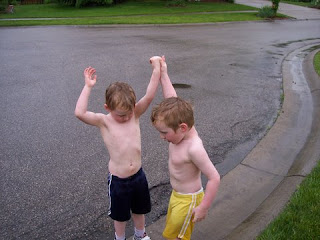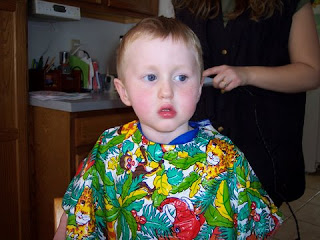I've always believed that shared DNA would have little or no influence on whether Matthew and Jonathan slept through the night. Overall, yes, it would make sense that biology would dictate how much sleep they need and about when they might tire.
But disruptions in sleep patterns are most often caused by dreams, right?
Experience influences dreams and, shared DNA does not always equal shared experiences.
Matthew and Jonathan are often together, but the slightest distractions -- from physical positioning to hunger to whether they might have to pee at the time -- can shape experiences differently for each child. They take in different things depending on how closely they are paying attention, which senses they are using and the perspective from which they see things.
Jonathan and Matthew have had three and a half years worth of differentiation.
That seems like a lot.
But something happened last night that made me question my theory, and it's not the first time.
Matthew woke up at about 3 a.m. He wasn't upset or worried. He was just awake. He used the bathroom and I took him back to bed, where we curled up together for about 45 minutes. Finally, I tip-toed out of his room, believing he was asleep.
About an hour later, I spied a young figure at the foot of our bed, I pulled him into bed with me, believing it was Matthew again. He'd awoken the same way: no crying, no worries, just awake. I was tired and he just wasn't crashing, so after a few minutes, my husband took him back to his room, where he realized Matthew's bed was occupied.
This was Jonathan.
About 45 minutes after he awoke, Jonathan was again asleep.
Just like Matthew.
Matthew and Jonathan are good sleepers. They always have been. They go down hard and they wake up early, but they sleep like rocks through the night. The few times they have awoken, however, (aside from those moments when they've wet their beds), their awakenings have been so similar in nature that I've found it almost eery.
If one awakens with a particular cry, the other will awaken with that exact same cry an hour so later -- close enough to his twin that we can compare the awakenings, but far enough apart that we can be sure one did not awaken the other.
If one awakens with no cry, the other will soon awaken the same way. And it seems that it takes about the same time and effort to get him back to sleep. Looking back, I don't recall that they have ever awakened differently unless one was sick or had the wet his bed.
I've tried to attribute these common awakenings to coincidence.
Maybe one twin tossed and turned in his sleep, triggering frightening dreams in the other.
Maybe one twin's awakening caused the others.
But their awakenings are too far apart to persuade me.
And it's happened far too many times.
I don't believe this is evidence of some kind of twin telepathy, but I have come to believe that brain chemistry strongly influences sleep patterns, especially in children . When our older kids woke up at odd hours, I initially attributed it to stress, bad dreams or other external influences.
But in retrospect, it seems that there was almost always a biological cause. Our oldest son suffered night terrors as a toddler, which are caused by mini seizures. I don't recall him waking up during the night much after those passed.
Our daughter had horrible, morbid dreams several times a night until she was diagnosed with OCD, which is caused by an anxiety-triggered chemical imbalance. Once she was treated with medication that stabilized those chemicals, she slept beautifully and still does.
As adults, we often have trouble sleeping because of external stresses. We're thinking about work, relationships, money, all kinds of things as we struggle to sleep and we often have trouble shutting those thoughts out. All that stress prevents us from producing the hormones and chemicals that override our worries and help us crash for the night.
At three years old, Jonathan and Matthew don't have many of those external worries.
And even if they did, what are the chances that their stresses are similar enough to cause them to awaken the same way on the same nights? No, I have to believe that it's their shared DNA that is behind their awakenings. Some sort of chemical change in brain pattern is occurring almost simultaneously.
And that makes me wonder about the way we approach childhood sleep disruptions as a society.
Perhaps too often biology is overlooked.
So often, I hear parents say that their children need to "get over it" when they frequently awaken during the night. They take the toughlove approach, simply sending them back to bed in hopes that they will get through this phase if no one pays them heed.
Matthew and Jonathan do not have sleep issues.
They rarely awaken.
But, the pattern I have observed when they do wake up during the night is strong evidence that some kids, perhaps many kids, can't help themselves.
Maybe some children need more than toughlove.
Maybe, more often than not, the awakenings that parents attribute to bad dreams, clinginess or a need for attention are really biology at work.















